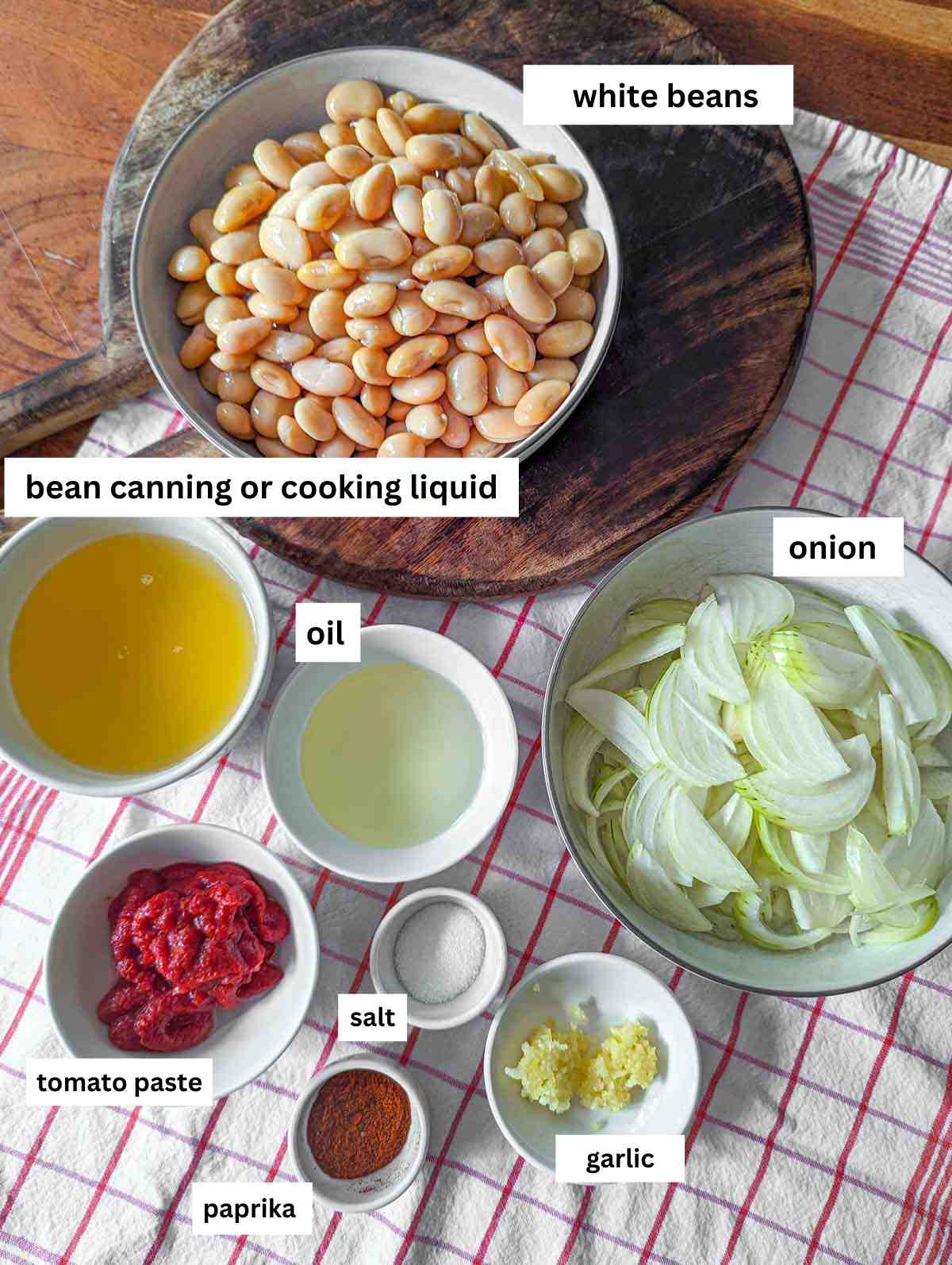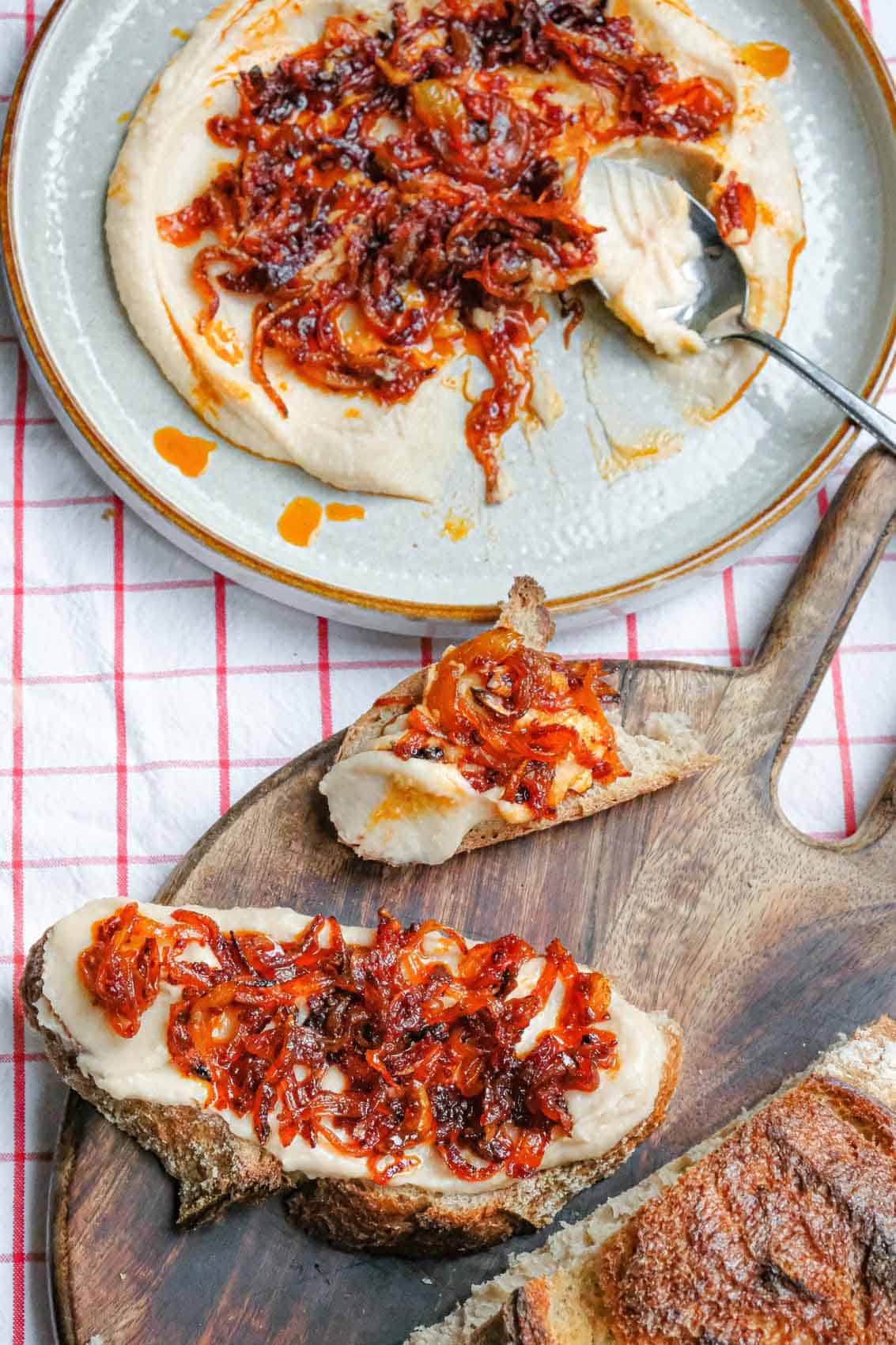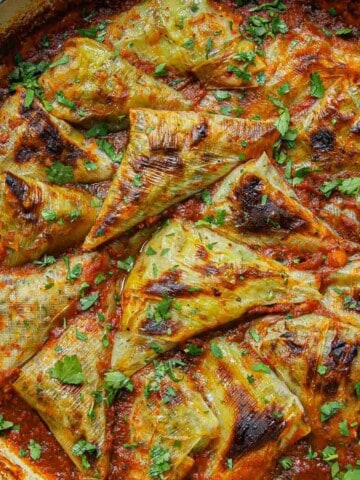Traditional Romanian white bean dip called fasole batuta is made up of a smooth and garlicky white bean base topped with sweet and smoky caramelized onions in a tomato paprika sauce.

Romanian white bean dip or fasole batuta is delicious because it's a dish that plays with contrasts. The whipped white beans are velvety, creamy and savory with a distinct brightness from the addition of raw garlic.
The caramelized onion topping is quite the opposite. Sweet and smoky with some texture and maybe a few sticky, chewy, crispy bits if you caramelize the onions just enough. It's also delicious served over homemade hummus.
When combined together the flavors are sensational. Unlike many other bean dips (and especially white bean dips) which tend to be made with bright and fresh ingredients, fasole batuta feels hearty and more like comfort food than the plant-based lenten staple it really is. You won't be able to stop eating it.
Romanians traditionally eat white bean spread around the holidays or during the various fasts during the Orthodox calendar, especially in the lenten period leading up to Easter. In the old days the beans would be whipped by hand, often with nothing but a fork. And this is of course after boiling the beans from dry.
Fortunately these days we have modern conveniences like canned beans and food processors that make this dish very simple and easy to prepare.
But don't worry, if you do want to do it the old fashioned ways I also provide some tips below under the instructions section for making fasole batuta with dry beans or without a food processor.
Ingredients
You only need a few ingredients to make Romanian white bean dip.

- Canned white beans: You can use any type of white beans (navy beans, lima beans, cannellini beans, great northern beans etc.) Dry white beans are also okay, see instructions section for tips on using them.
- Bean canning or cooking liquid: Some of the canning or cooking is added to the food processor to make the beans extra light and smooth.
- Garlic: This is the main flavor note in the beans.
- Yellow onions: Yellow onions are traditionally used but other types are also okay.
- Tomato paste: The tomato paste adds depth and umami flavor to the caramelized onions.
- Oil: Any odorless flavorless vegetable oil to caramelize the onions and tomato paste. Sunflower or canola are traditional choices but grapeseed, avocado or peanut are also fine.
- Paprika: This is key for giving the caramelized onions their distinctive flavor. My preference is for smoked paprika (I love La Chinata Sweet Smoked Paprika and don't use anything else) but sweet Hungarian paprika is also a good option.
- Salt: Just enough to bring out the flavors.
See recipe card for quantities.
Instructions for making fasole batuta Romanian white bean dip
There are two steps involved in making fasole batuta.
- Prepare the whipped beans;
- Prepare the caramelized onions.
How to prepare the white beans
The white beans are simply drained, reserving a quarter to a half cup of liquid. Add the beans, a quarter cup of canning liquid, salt and garlic to the bowl of a food processor and blend until smooth as shown below.

Combine all spices into a large bowl and mix thoroughly into lean ground beef

Form into ball shape with your hands
How to start with dry beans
If you want to start with dry beans, measure out just a little more than half a cup of dry beans. This is equivalent to the amount of beans used in this recipe.
This recipe is made using one large drained can of white beans that weighs approximately 450 grams or just under 16 oz / 2 cups.
- Soak ½ cup of dry beans overnight or for at least 8 hours.
- Drain the beans and put them in a large pot with enough salted water to cover.
- Cook covered over medium heat for 1.5 to 2 hours or until the beans are fork tender.
- If you have a pressure cooker you can cut the cooking time in half.
How to whip the beans without a food processor
It takes much more time and effort to make the beans without a food processor, but it can be done.
The best option is to do like grannies do and use a fork. If you have a potato masher or ricer that could also be an option.
As you mash you may notice the skins of the beans create chunks. You can address this by either pulling all the skins off first before mashing. This may be quite tedious so another option could be to mash the beans and then press them through a wide mesh sieve.
Be sure the garlic is also very fine, either using a garlic press, mortar and pestle or very finely dicing it.
How to prepare the caramelized onions

Add the onions, tomato paste, oil salt, and a dash of the paprika to a non-stick skillet over low to medium-low heat.

Stir well to coat the onions fully and cook, stirring often, until the onions start to soften. Add the paprika after about 10 minutes.

It should take about 18-20 minutes for the onions to caramelize. They are finished when they've significantly reduced in volume and may start to look a bit crisp.
Tip: careful not to burn the onions
The onions take a while to evaporate their water and start crisping up and caramelizing. But once they do start they can go from caramelized to burnt very quickly. So be sure to keep a close eye after the 15 minute mark.
Equipment
Food processor: A food processor makes the recipe much easier and faster.
Non-stick skillet: A non-stick skillet will allow the onions to caramelize rather than sticking. A well-seasoned cast iron pan can also work.
Serving Suggestion
It's traditional to serve fasole batuta spread thinly over a plate and sprinkled with the caramelized onions as shown in the photos.
Crusty bread is a classic accompaniment, but sometimes you'll also see it served with pickles (cucumber, cauliflower or tomato) and maybe smoked meat like smoked sausage.
This recipe make enough for two dinner sized plates as shown in the photos, or one slightly deeper plate could fit the whole recipe.
This recipe makes a good appetizer or snack sized portion for 6-8 people.

Storage
Store the bean dip in the fridge for up to 4 days. It will probably end up getting mixed together so the caramelized onions are no longer a topping but mixed in but that doesn't take away from the flavor at all.
Top tip
The bread you serve the fasole batuta with it just as important as the beans themselves.
Pick a good loaf (or make your own) to make the most of this flavorful bean spread.
Pairing
Looking for other recipes like this? Try these:
Related
Looking for more recipes made with beans and legumes? Try these:
Recipe

Fasole Batuta: Romanian White Bean Spread with Garlic & Caramelized Onion
Equipment
- food processor
- non-stick skillet
Ingredients
- 450 grams canned white beans one standard-sized small can (15.5oz) or substitute ½ cup / 90 grams dried
- 60 ml bean canning liquid
- 1.5 cloves garlic more or less depending on taste
- 2 yellow onions sliced
- 1.5 teaspoons smoked paprika
- 3 tablespoons tomato paste
- 125 ml sunflower oil or other neutral oil
- 1.25 teaspoons salt more or less to taste
Instructions
- Add the drained beans, ¼ cup canning liquid, half the salt and garlic to the bowl of a food processor and blend until very smooth.
- Slice the onions and add them along with the oil, tomato paste, rest of the salt, and a dash of the paprika to a non-stick skillet over low to medium low heat.
- Mix so the onions are evenly coated with the tomato paste.
- Cook the onions over low to medium-low heat for 10 minutes, stirring a few times in between.
- Add the rest of the paprika and cook another 8-10 minutes, stirring frequently until the onions are significantly reduced in volume and starting to crisp up.
- Keep a close eye on the onions after the 15 minute mark. Remove them from heat if they look like they're browning too quickly. They can do from caramelized to burnt very quickly.
- To serve, spread some of the whipped bean and garlic mixture in a relatively flat bowl and then spoon some of the caramelized onion topping over it. Enjoy with fresh bread either as a spread or a dip.











Comments
No Comments